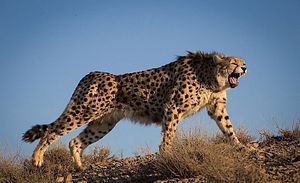Here at Crossroads Asia, we like to take occasional breaks from the assorted tales of kleptocracy and disappointing infrastructure projects coursing Central Asia to check in on regional tales that deserve a bit more play and that inspire a bit more optimism. One such story cropped up earlier this week, when National Geographic ran a post from Tatjana Rosen. Detailing Rosen’s recent travel through Turkmenistan, the post notes the author’s — and President Gurbanguly Berdymukhamedov’s — affinity for the country’s Akhal Teke horse, as well as the country’s “rugged beauty” and “welcoming people.”
Aside from the travelogue language, however, Rosen posits a question that, at last check, remains unanswered: Could the Asiatic cheetah, extinct in Turkmenistan since the Soviet period, “have crossed into Turkmenistan from Iran?”
Rosen’s query remains unanswered, but a few intriguing details — eyewitness and otherwise — leave the question open. For instance, Persian leopards have begun encroaching on Ashgabat, one of which has “likely settled” near Turkmenistan’s capital. Elsewhere, a Turkmen horse breeder told Rosen he spotted an Asiatic cheetah recently in western Turkmenistan. More cheetahs have been spotted in Iran’s northeastern reaches, while a “hunter report” from three years ago “indicat[ed] the possibility of cheetah presence” near the Iran-Turkmenistan border.
The potential sightings are phenomenal news, for any number of reasons, least of all because it would seem to indicate that the Soviet-era hunting and environmental damage that ravaged Turkmenistan’s cheetah populations may not have been permanent. Likewise, the Asiatic cheetah population in Iran has been decimated in recent years, with only two female Asiatic cheetahs living in the wild at last check. Bringing in further stakeholders to preserve the Asiatic cheetah populations should, presumably, only increase the odds of expanding the population. (A similar phenomenon has recently played out regarding jaguar populations moving northward into the United States.)
Experts have previously recommended the reintroduction of Asiatic cheetah populations into the region, a move that would mirror efforts underway to reintroduce tigers to Central Asia. While such tigers wouldn’t be the Caspian tiger subspecies now eradicated — they would likely be Siberian tigers relocated from Russia — they would nonetheless help repopulate a region that once boasted some of the biggest felids the world has ever seen.
Until then, though, local researchers in Turkmenistan will continue to keep a keen eye, looking to spot the first cheetah the country has seen in decades. Thankfully, if Ashgabat needs any tips on feline preservation efforts, government officials won’t need to go far to check in on Bishkek’s work to rehabilitate its snow leopard population.
So welcome back to Central Asia, big cats. And may you remain for decades to come.

































